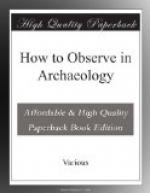Tombs are of all periods, and are found not only around historical sites and actual ruins, but also in localities where the settlement to which they belonged has wholly disappeared. Though simple graves were always in use among the poorest folk, the commonest form of tomb at all periods is a rock-cut chamber entered by a door in one side, to which access is given by a shaft or sloping passage (dromos) cut likewise in the rock. The earliest are but a few feet from the surface, just deep enough to ensure a firm roof to the chamber; later the depth is as much as 12 or 15 feet. Occasionally the chamber, and even the passage, is built of masonry and roofed with stone slabs or a corbel vault, and the simple door-slab gives place to a stone door, hinged, or sliding in a grooved frame. Cremation was occasionally practised in the Hellenistic Age, but the regular custom was to bury the body; during the Bronze Age in a sitting or a contracted posture, in all later periods lying at full length. Stone coffins (sarcophagi), with a lid, were used occasionally by the rich from the sixth century onwards, and wooden coffins in the Graeco-Roman period. There is always as rich a tomb-equipment as the mourners could afford, of personal ornaments, wreaths, provisions, weapons, and other gear, especially pottery; and terra-cotta figures of men, animals, furniture, and other objects for the use of the deceased. In Graeco-Roman tombs pottery is supplemented or replaced by glass vessels, and coins are frequent, and are important evidence of date. Most of our knowledge of Cypriote arts and industries comes from this tomb-equipment, which should therefore if possible be preserved entire and kept together, tomb by tomb; not neglecting the skeletons themselves, which are of value to indicate changes in the island population. The position of tombs was often marked by gravestones above ground; these remain scattered in the surface soil, or collected to block the entrances to later tombs. They are frequently inscribed. A very common form in Greco-Roman times is the cippus, a short column, like an altar.
Pottery and other objects
from tombs, and also from settlements, is classified
as follows:
Stone Age: not clearly represented in Cyprus; but some of the earliest tombs (with rude varieties of red hand-made ware) contain no metallic objects, and may belong to the latest neolithic period. Stone implements are very rare, and should be carefully recorded, with a note of the spot where they were found.
Bronze Age, early period (before 2000 B.C.): polished red ware, hand-made, sometimes with incised ornament filled with white powder.
Bronze Age, middle period (2000-1500 B.C.): polished red ware, and also white hand-made ware with painted linear ornament in dull black or brown.
Bronze Age, late period (1500-1200 B.C.): degenerate polished red and painted white ware; wheel-made white ware with painted ornament in glazed black or brown, of the ‘Late Minoan’ or ‘Mycenaean’ style introduced from the Aegean; various hand-made wares of foreign styles, probably from Syria or Asia Minor.




